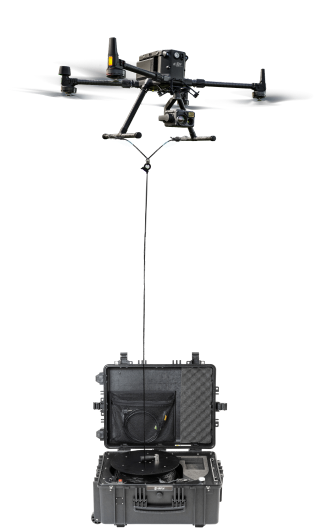Firefighting Drone: How does it help Fire Departments?
Amid this alarming reality, drones are playing a transformative role in the public sector. These unmanned aerial vehicles are now being used by firefighters, equipping them with the latest technology and capabilities to improve their effectiveness and situational awareness during emergencies. Read on to find out how the firefighting drone is helping fire departments in their vital work of saving lives and property.
Are Firefighting Drones Effective for Emergency Response?
Firefighting drones are a type of public safety drones that can serve as a first responder. These small unmanned aerial vehicles (UAVs) are equipped with advanced technologies, like the thermal camera, to assist firefighters in critical situations.
One of the most important roles of the firefighting drone is to provide continuous surveillance of wildfires. They act as eyes in the sky, capturing uninterrupted aerial views of fires in natural environments.
UAVs can also be used to monitor traffic and hazardous incidents like gas leaks from vehicles such as a rail car.
6 Ways Drones can Help Fire Departments
#1 Safety and Risk Assessment
Firefighting drones can serve as a first responder since they provide aerial imagery before crews are dispatched, thereby minimizing risks to firefighters on the ground. This can include identifying areas with high concentrations of combustible materials or gas, or collapsing roofs.
Also, training and simulation drones can be used as part of fire simulation exercises for training purposes.
#2 State-of-the-art features
The firefighting drone is equipped with LiDAR (Light Detection And Ranging) sensors and thermal imaging cameras to identify targets in smoke and gather vital information for improved public surveillance.
In both wildland and urban fires, the thermal camera enables rapid and targeted intervention by detecting heat, fire starts, progression, and risk of reignition. It can also help locate people in danger, identify exits, and find hotspots invisible to the naked eye. As a result, law enforcement teams can deploy resources to the most critical areas and protect units on the ground.
Additional payload options include foam dispensers, water cannons, and dry powder to assist with fire suppression.
A firefighter drone equipped with speakers can quickly communicate with people in danger and provide valuable information to rescue teams.
#3 Real-Time Aerial Surveillance and Data Collection
The firefighting drone can share real-time video of incidents, helping the Emergency Operations Commander (EOC) to make critical decisions and expedite emergency response.
They can also assign the appropriate team to manage the situation, such as a chemical risk unit.
#4 Communication and Coordination
Drones can act as relays in areas where traditional communication devices may be hindered by fire interference.
#5 Post-Fire/Dangerous Event Assessment
The firefighting drone can share real-time video of incidents, helping the Emergency Operations Commander (EOC) to make critical decisions and expedite emergency response.
They can also assign the appropriate team to manage the situation, such as a chemical risk unit.
#6 Cost-Effectiveness vs. Traditional Methods
UAVs can reduce the need for manpower, specialized equipment, and infrastructure, making them a more economical solution.
“Rather than competing with each other, tethered and conventional drones augment each other’s capabilities. Tethered drones are primarily used to monitor specific areas, while specialized models like firefighter ones or police drones, can be mobilized to go to the appropriate location and perform precise actions, such as extinguishing fires.”
Limitations of Drone use in Firefighting Scenarios
While these drones are invaluable in aiding firefighting efforts and serving as a complement to existing equipment such as fire trucks, they do have certain limitations …
- Short temps de vol and limited mobility due to heavy payloads. In contrast, tethered drones have much greater endurance than free drones and therefore, are less impacted by the flight duration on a mission.
- Vulnerability to harsh temps favorable, such as high winds, rain, and extreme temperatures.
- Airspace safety concerns, necessitating precise coordination to prevent mid-air collisions and interference.
Given the high stakes involved in firefighting scenarios, it is imperative to deploy responsive and reliable drones that can provide continuous updates, enabling fire departments to reduce response times.
The future use of a firefighter drone in public safety is promising, thanks to the anticipated evolution of onboard technologies such as thermal imaging cameras. These advancements are opening up new avenues for improved disaster and emergency response.
Firefighting Drone FAQ
How do firefighting drones assist in emergency responses?
Firefighting drones serve as first responders, equipped with thermal cameras and other advanced technologies to provide continuous aerial surveillance, helping firefighters assess situations and respond more effectively.
What state-of-the-art features do firefighting drones have?
These drones used to fight fires are equipped with LiDAR sensors, thermal imaging cameras, foam dispensers, water cannons, and speakers, enabling them to detect heat, locate people, and assist in fire suppression and rescue operations.
What role do firefighting drones play in post-fire assessments?
Firefighting drones collect real-time data during incidents, which can be analyzed to
improve future firefighting strategies, coordination, and feedback, ultimately enhancing overall emergency response effectiveness.
What safety and risk assessments can firefighting drones perform?
Firefighting drones provide aerial imagery to identify hazards such as high concentrations of combustible materials or structural weaknesses, minimizing risks to firefighters and enhancing their situational awareness.
How do firefighting drones enhance communication and coordination during emergencies?
Drones act as communication relays in areas where traditional devices may fail, ensuring continuous coordination and real-time information sharing between emergency teams and the Emergency Operations Commander.
What are the cost-effectiveness benefits of using firefighting drones compared to traditional methods?
Firefighting drones reduce the need for extensive manpower, specialized equipment, and infrastructure, offering a more economical solution for emergency response while enhancing the effectiveness of firefighting operations.





